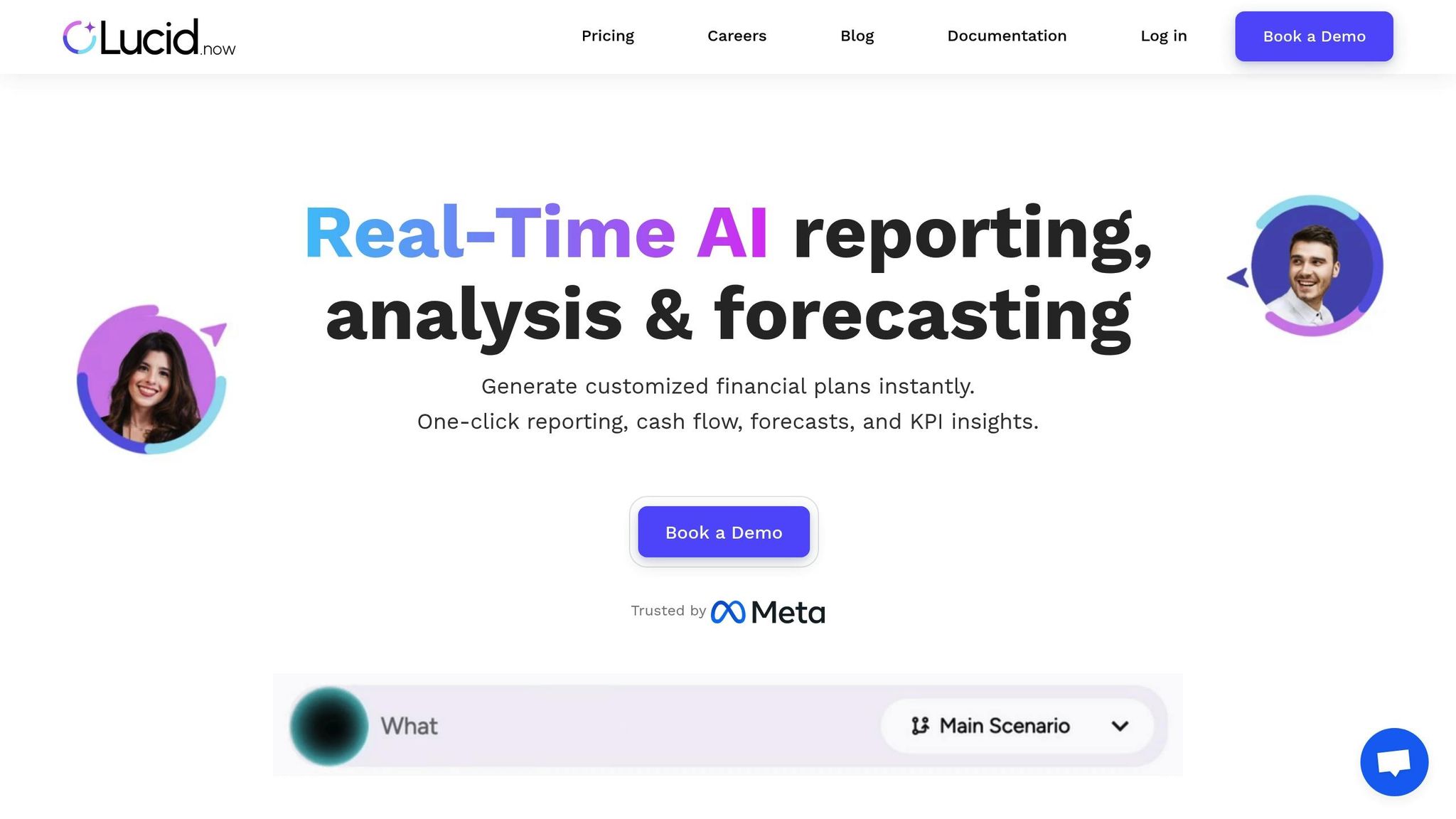When late-stage investors back your startup, they expect a clear roadmap to returns. Here's the reality: only 1.5% of startups achieve exits worth $50M+, while 90% fail. To meet investor expectations, you need an exit strategy that aligns with their ROI goals and timelines.
Key takeaways:
- Investor ROI Expectations: Late-stage investors aim for 3–5x returns within 3–7 years. Acquisitions are often preferred due to quicker and predictable outcomes, while IPOs demand strong financial performance and regulatory compliance.
- Exit Options: Match your company’s strengths to the right exit route - acquisition, merger, IPO, or buyout. Market timing, industry trends, and buyer readiness are critical factors.
- Financial and Operational Preparation: Maintain GAAP-compliant financials, resolve legal and operational issues, and use tools for scenario planning to showcase potential outcomes.
- Deal Structuring: Optimize tax strategies and use waterfall analysis to map proceeds distribution, ensuring fair returns for all stakeholders.
- Stakeholder Communication: Regular updates and transparent financial modeling keep investors aligned and confident in the process.
Exit Strategy for Investors: A Guide with Examples
Understanding Investor ROI Expectations
Before crafting your exit strategy, it’s essential to grasp what late-stage investors expect. Aligning with their priorities allows you to shape your financial and operational plans to meet their goals.
Setting ROI Targets and Timelines
Late-stage investors generally aim for returns of 3–5x on their investments. This lower target compared to early-stage investors reflects the reduced risk they face at this stage. These investors typically hold onto their investments for 3–7 years, making a clear and timely liquidity path a critical factor in their decision-making.
When looking at venture capital performance, top-tier VC funds tend to deliver annual returns between 15% and 27%, while the global VC fund median hovers around 13.2%. However, the landscape has shifted in recent years. For instance, in 2023, venture capitalists returned just $26 billion to investors - the lowest figure since 2011. If your exit strategy stretches beyond seven years or falls short of these return benchmarks, you may struggle to maintain investor confidence.
These ROI targets and timelines serve as a foundation for evaluating and refining your exit options later on.
Common Exit Preferences of Investors
When it comes to exits, late-stage investors typically lean toward acquisitions over IPOs. Acquisitions are faster, more predictable, and provide a clearer path to liquidity. Strategic buyers often pay a premium compared to financial buyers, making acquisitions a more reliable way to achieve the desired 3–5x returns.
That said, investor preferences can vary. Some prioritize strategic exits, where a startup’s technology or assets are integrated into a larger company’s ecosystem. Others may prefer financial exits, such as IPOs, to capitalize on public market valuations. The key here is communication - understanding your investors’ specific goals will help you align your exit strategy with their expectations.
Liquidity Preferences and Investment Agreements
Another critical factor is the liquidation preferences outlined in investment agreements. These preferences dictate the order in which payouts are distributed during an exit, with venture capitalists typically receiving their share before other stakeholders. Late-stage investors often negotiate for stronger liquidation preferences to balance the higher valuations and risks they assume.
The structure of these preferences matters significantly. For instance, non-participating preferences tend to benefit founders, while participating preferences - especially those with 2x clauses, which are increasingly common - offer greater advantages to investors.
Mark Suster highlights the potential challenges of liquidation preferences:
"Having a large amount of liquidation preferences sometimes creates 'flat spots' where some investors become indifferent to the ultimate price you sell your company between wide ranges of outcomes."
If your company has a complex preference stack, it’s crucial to plan accordingly. You may need to target higher-value strategic buyers or explore alternative exit structures that ensure fair returns for all stakeholders. Mapping out these preferences early will help you navigate exit scenarios and work toward achieving the desired valuations.
Choosing and Validating Exit Options
Once you’ve clarified investor ROI targets, the next step is to determine the right exit pathways. This involves evaluating potential routes, understanding market timing, and identifying suitable acquirers.
Matching Exit Routes to ROI Models
Exit strategies must align with the ROI goals and timelines discussed earlier - typically aiming for 3–5x returns within 3–7 years. Acquisitions account for about 60% of startup exits, while IPOs, though less common, have grown from 10% to 15%. Each option affects the likelihood of meeting investor expectations differently.
Strategic acquisitions often deliver predictable returns and align well with investor goals. IPOs, on the other hand, can offer higher returns but come with added complexity and costs. Public offerings demand compliance with strict regulations and require a company to maintain strong growth and financial performance to satisfy market scrutiny.
| Exit Strategy | Typical Timeline | Benefits | Challenges | Best For |
|---|---|---|---|---|
| Acquisition | 2–7 years | Predictable valuations, access to resources | Integration issues, potential loss of control | Companies with strong product-market fit |
| Merger | 3–5 years | Synergies and shared resources | Cultural differences, management conflicts | Companies seeking complementary strengths |
| IPO | 5–10+ years | Access to significant capital, increased visibility | Regulatory hurdles, market volatility | High-growth companies with scalable models |
| Buyout | Varies widely | Retain independence, potential for higher returns | Finding the right investors, managing debt | Established, profitable companies |
The key is to match your company’s strengths to the most suitable exit model. For instance, companies with protected intellectual property or strategic partnerships often command higher acquisition premiums. Meanwhile, businesses with loyal and expanding customer bases may be better candidates for IPOs.
Analyzing Market Conditions and Timing
Market conditions play a huge role in determining the success of an exit strategy. Favorable trends can significantly boost valuations, while downturns may force delays.
Recent data highlights the importance of timing. By Q1 2025, VC-backed exits hit record lows due to a drop in IPO activity. However, corporate-backed startups showed resilience, with January 2025 seeing 53 deals worth $4.52 billion - the highest in two years.
A great example of timing is Airbnb’s decision to delay its IPO in 2020 until market conditions improved, which ultimately boosted its valuation and ensured a strong public debut.
For companies in booming sectors like AI, acquisition opportunities are plentiful, but it’s crucial to align timing with buyer interest and market demand.
When evaluating market conditions, consider:
- Economic trends: These influence both investor appetite and buyer behavior. For instance, strategic buyers may become cautious during economic uncertainty, while financial buyers might seek undervalued opportunities.
- Market sentiment: Collective investor and consumer attitudes can determine whether startups aggressively pursue exits or hold back.
- Industry-specific trends: Timing your exit to align with industry growth can make a big difference. Tesla, for example, entered the electric vehicle market when environmental concerns and technological advancements were at their peak.
- Competitive landscape: Market saturation or competitor activity can sometimes accelerate the need for an exit.
Strategic timing isn’t just about waiting for the perfect moment - it’s about preparing to act swiftly when conditions align.
Identifying Potential Acquirers
Once you’ve assessed market timing, the next step is identifying acquirers whose strategies align with your exit goals. Building relationships with potential buyers early - long before you’re ready to sell - can make all the difference.
Start by creating a detailed list of potential buyers. Look for companies that would gain value from your technology, customer base, or market position. Research their strategic priorities and past acquisitions to ensure alignment.
Key factors to evaluate include:
- Success rates in previous acquisitions
- Financial resources and capital availability
- Strategic goals and values
- Ability to integrate new businesses, retain talent, and manage transitions
Networking is equally important. Attend industry events, form strategic partnerships, and stay in touch with corporate development teams. Early connections can set the stage for smoother negotiations later.
Understanding an acquirer’s mindset is crucial. Most strategic buyers prefer companies with proven track records, strong operational foundations, and access to new markets. Research their recent activities: Have they made similar acquisitions? Are they expanding into areas where your company excels? Do they have the resources to meet your valuation expectations?
"We need to understand the current market demand, whether it's growing or declining, and assess whether the startup is merely replacing an existing product or pioneering a new category." - Vinod Keni, Co-Founder & Managing Partner, Peachtree Venture
This highlights the importance of standing out. Companies that create new categories or address growing market needs often attract acquirers willing to pay premium valuations.
Finally, maintain flexibility by keeping multiple exit options open. Relying on a single acquirer or route can leave you vulnerable if market conditions shift. A robust pipeline of potential buyers strengthens your negotiating position and ensures you’re prepared to act when the timing is right.
Preparing Financials and Operations
Strong financial records and efficient operations are the backbone of any successful exit strategy. Whether you're eyeing an acquisition or an IPO, potential buyers and investors will meticulously examine every detail during due diligence. This preparation is essential for maximizing your company's valuation and meeting investor expectations for returns.
Maintaining GAAP-Compliant Financials
If you're planning an exit, GAAP compliance isn’t optional - it’s essential. Acquirers and public markets will carefully review your financial statements to ensure they align with Generally Accepted Accounting Principles (GAAP). Any deviations could lead to adjustments in the purchase price.
For public offerings, you’ll need at least two years of GAAP-audited financials. Starting early with GAAP-compliant records can save you time and money when audits are required, making the IPO process smoother.
"When evaluating your organization for investment opportunities, venture capitalists will want to build investment models and compare key performance metrics to benchmarks. Providing them with GAAP-basis financials provides instant credibility and demonstrates that you are conveying your financial information in a way that they can easily understand and compare to others."
– Carolyn Zhang, EisnerAmper
Certain areas of GAAP are particularly important for tech startups, such as research and development costs, stock-based compensation, and revenue recognition. Investors often zero in on metrics like revenue, net income, and gross profit. To stay compliant, establish clear accounting policies early and stick to them. Also, structure your chart of accounts to meet managerial needs while adhering to GAAP.
These practices not only ensure compliance but also pave the way for effective scenario planning.
Using Lucid Financials for Scenario Planning

When preparing for an exit, scenario planning is a powerful way to show investors how different market conditions could impact their returns. Lucid Financials offers tools to model various exit scenarios, helping you present a clear vision of your company’s potential.
With Lucid Financials, you can analyze factors like revenue growth, cost structures, and market expansion to explore multiple exit pathways. This type of modeling not only answers investor questions but also showcases your strategic foresight.
The platform’s industry benchmarking features allow you to compare your company’s performance against sector standards. This objective data is critical during negotiations, reinforcing your valuation and ROI projections.
Key financial metrics to incorporate in scenario planning include revenue growth, gross margin, operating expenses (especially R&D and SG&A), EBITDA, capital expenditures, and liquidity. Integration with tools like QuickBooks, payroll systems, and banks ensures access to real-time data for accurate projections.
Lucid Financials also simplifies investor communication with reporting tools that provide regular updates. Keeping stakeholders informed helps maintain their confidence throughout the exit process and aligns plans with their ROI expectations.
Fixing Operational Problems
Operational issues can significantly impact your company’s valuation. For example, unresolved legal problems could reduce your startup's value by 15%–25%. Tackling these challenges early not only protects your valuation but also signals professional management to potential buyers.
Legal compliance is a key concern for buyers. They’ll want assurance that there are no unresolved debts, legal disputes, or liabilities tied to the business. This includes formalizing intellectual property agreements, registering trademarks and patents, and ensuring tax compliance from the outset.
"Buyers usually want to be sure that there's no outstanding indebtedness or unresolved matters, or other liabilities between the founders and the business."
– Daria Kurishko, Head of Startup Legal, Legal Nodes
Protecting intellectual property (IP) should be a priority. Make sure every freelancer, contractor, and employee who contributes to your product signs agreements transferring IP rights to the company. Register trademarks and document all agreements made before the startup was founded.
Accurate financial records go beyond GAAP compliance. Keep detailed documentation of revenue, expenses, and cash flow, ensuring that the costs reflected in your managerial financial statements align with those used in pricing calculations.
Risk management is another critical area. Develop processes to identify and address operational, market, competitive, financial, regulatory, and reputational risks. Proactively managing these risks minimizes surprises during due diligence.
Finally, conduct regular audits to catch potential issues early. Annual legal audits and ongoing financial reviews can uncover problems before they escalate, demonstrating strong governance and ensuring compliance.
sbb-itb-17e8ec9
Structuring the Exit for Maximum ROI
Once your financials and operations are in order, it's time to focus on structuring your exit in a way that maximizes investor returns. The approach you take with deal structures, tax planning, and stakeholder communication can greatly influence the final outcome for everyone involved.
Fine-Tuning Deal Structure and Tax Planning
The structure of your deal and the associated tax implications play a major role in determining the net proceeds from your exit. For instance, understanding the difference between ordinary income tax rates (up to 37%) and long-term capital gains tax rates (0% to 20%) can lead to substantial savings for investors and founders alike.
Your choice of entity structure also impacts the tax results. Partnerships and LLCs benefit from pass-through taxation, which avoids double taxation. On the other hand, C-corporations face double taxation but offer perks like the Qualified Small Business Stock (QSBS) exemption. This exemption can allow founders to exclude up to $10 million - or 10 times the original investment - from capital gains taxes.
The method of acquisition further affects tax outcomes. Stock purchases and reverse triangular mergers (RTMs) generally favor sellers by offering better capital gains treatment and potential QSBS benefits. Meanwhile, buyers often prefer asset purchases because they allow for a step-up in basis, enabling depreciation of acquired assets at fair market value.
Timing is another critical factor. Proper planning ensures eligibility for long-term capital gains treatment and QSBS benefits, which require a five-year holding period. Engaging a qualified tax advisor early in the process can help you explore various scenarios, estimate after-tax proceeds, and navigate complexities like the 3.8% Net Investment Income Tax (NIIT) for high-income earners.
With a solid deal structure and tax strategy in place, you can move on to modeling the financial outcomes of your exit.
Modeling Exit Scenarios to Understand Returns
Waterfall analysis is a powerful tool for mapping out stakeholder returns based on different exit valuations. It provides a clear breakdown of how proceeds will be distributed among founders, investors, and other stakeholders.
"Waterfall analysis is more than just a spreadsheet - it's a window into your company's financial outcome." – Team Qapita
For example, imagine a company that raised $1 million in a Seed round (1x non-participating preference, 10% stake), $4 million in Series A (2x participating preference, 25% stake), issued a $1 million SAFE (converting to 5% at exit), allocated 10% to an employee equity pool, and left founders with 50%. If the company exits for $25 million, the proceeds might look like this:
- Seed investor: $1 million
- Series A investor: $8 million plus $4.44 million
- SAFE holder: $0.89 million
- Employee equity pool: $1.78 million
- Founders: $8.89 million
Dynamic tools like Lucid Financials make it easier to model these scenarios, allowing you to test different variables such as revenue growth, cost structures, and market conditions. Additionally, benchmarking features let you compare your projected returns against industry standards, giving you valuable insights for negotiations.
It’s worth noting that venture capitalists often aim for returns of 25% to 35%, but more than 66% of startups fail to deliver positive returns to investors. Your modeling should present realistic paths to achieving these targets under various scenarios.
Keeping Stakeholders in the Loop
Clear and consistent communication with stakeholders is key throughout the exit process. Establishing a regular communication plan ensures everyone stays aligned and informed.
Tools like Lucid Financials simplify this process by offering automated reports that provide updates on key metrics and progress toward exit goals. Visual aids, such as charts and graphs, can make complex waterfall calculations easier to understand, boosting stakeholder confidence.
"As a founder, use waterfall modeling to inform how you raise capital, negotiate terms, and plan your company's exit. Don't wait until a term sheet lands to understand your outcome. Model it now." – Team Qapita
Regular board meetings and investor updates should include discussions about exit planning, market conditions, and potential acquirers. This keeps everyone informed about factors that could influence the timing and success of the exit.
Lastly, ensure thorough documentation. Keep detailed records of stock ownership, holding periods, and any tax liabilities that may arise. This level of preparation not only builds trust but also ensures a smoother exit process.
Monitoring and Adjusting Exit Readiness
Once your exit strategy is in place, the work doesn’t stop there. To ensure your plans stay effective, you need to keep a close eye on how things evolve. Market dynamics, company performance, and investor expectations are always shifting. Regular reviews and adjustments are crucial to keeping your exit strategy aligned with investor goals and maximizing ROI.
Conducting Annual Exit Reviews
Annual reviews act as a critical checkpoint to measure progress and tackle potential issues before they escalate. It’s a good idea to schedule these reviews at the end of your fiscal year with your board, investors, and advisors.
During these reviews, assess key performance indicators like revenue growth, market share, and operational efficiency. Identify any gaps between your current performance and what investors expect. If there are discrepancies, create actionable plans to address them. It’s also a good time to revisit contingency plans, ensuring you’re prepared for unforeseen challenges like market downturns or increased competition.
Updating Financial Models Based on Market Changes
Your financial models should be living documents, constantly updated to reflect the latest business and market conditions. Quarterly updates are ideal for keeping your projections realistic and grounded in actual performance data. By comparing forecasts to real-world results, you can identify trends and adjust for overly optimistic assumptions about sales cycles, customer behavior, or operating costs.
Stress testing your financial models is also essential. Simulate scenarios like economic slowdowns, rising competition, or supply chain disruptions. Incorporating best-case, worst-case, and most-likely scenarios into your models ensures you’re prepared to adapt quickly when conditions change.
Using tools like Lucid Financials can streamline this process. Its benchmarking features let you validate your assumptions against industry standards, and automated updates ensure your models stay current. As new data comes in, refine your revenue forecasts and cost estimates to keep everything aligned with market realities.
Keeping Multiple Exit Options Open
Flexibility is a cornerstone of effective exit planning. Since market conditions, investor preferences, and company performance can shift, having multiple exit paths ready allows you to seize opportunities as they arise.
Stay connected with potential acquirers by attending industry conferences and networking events. Understanding what strategic buyers are looking for ensures you’re prepared when the right opportunity comes along. Even if an IPO isn’t your primary goal, keep an eye on the public offering landscape and regulatory changes. Monitoring similar companies in your sector can provide valuable insights into valuation trends and investor sentiment.
Maintain open communication with your investors about potential exit routes and market opportunities. Their perspectives can uncover new possibilities and help you forge connections. Whether you’re considering strategic acquisitions, financial buyer deals, or IPOs, evaluate how each option aligns with your company’s current position. Engage your leadership team in these discussions to ensure everyone understands their role in driving valuation and preparing for potential pivots as conditions evolve.
Conclusion: Main Points for Aligning Exit Plans with Investor ROI
Getting your exit strategy in sync with investor ROI expectations boils down to thoughtful planning, clear communication, and adaptability. It begins with understanding your investors' goals and timelines since their unique objectives often drive exit decisions.
Being financially transparent is a must. Keeping GAAP-compliant financials and using tools like Lucid Financials for scenario planning can help you stay prepared for market changes. This level of transparency also makes it easier to communicate with stakeholders about valuation goals, potential risks, and strategic opportunities.
Consistent updates and reviews are just as important. They allow you to spot issues early and keep everyone on the same page. For example, annual board reviews, quarterly financial model updates, and regular market analyses can highlight gaps between performance and investor expectations before they escalate.
Lastly, flexibility in your exit planning is critical. Having multiple exit strategies in place allows you to seize new opportunities while addressing the diverse ROI needs of your investors. Pairing this flexibility with careful oversight ensures you're ready to adapt as circumstances evolve.
FAQs
What’s the difference between an acquisition and an IPO, and how can a startup choose the right path?
The key distinction between an acquisition and an IPO lies in the process and the outcomes they deliver. An acquisition means selling the company, often resulting in a faster exit with fewer regulatory hurdles. On the other hand, an IPO (Initial Public Offering) involves taking the company public, which can provide access to substantial capital, boost visibility, and allow founders to retain some level of control. However, IPOs come with higher costs and stricter compliance requirements.
When deciding between these two paths, startups need to weigh factors like their current growth stage, the state of the market, and their long-term objectives. Acquisitions tend to work well for those looking for a streamlined and quicker exit. Meanwhile, IPOs are better suited for businesses prepared for significant scaling and the responsibilities of operating in the public market. Ultimately, aligning your decision with investor expectations and return goals is crucial to choosing the right direction.
How can startups ensure their financials comply with GAAP, and why does this matter for investor ROI?
Startups can align their financial practices with Generally Accepted Accounting Principles (GAAP) by adopting standardized methods that prioritize accuracy, clarity, and consistency. This means keeping detailed financial records, adhering to GAAP rules for recognizing revenue and tracking expenses, and conducting regular audits of financial statements.
Following GAAP is crucial for meeting investor expectations for returns. It establishes trust by offering reliable and consistent financial data, enabling investors to accurately gauge the startup's performance, understand potential risks, and make informed decisions about funding, valuation, or possible exit strategies.
How can startups build relationships with potential acquirers early to ensure a smoother exit process?
To lay the groundwork for future acquisitions, startups should focus on identifying strategic buyers whose objectives align with their own. This requires thorough market research and staying informed about industry trends to pinpoint the right potential partners.
Networking plays a crucial role here. Attend industry conferences, engage in online forums, and connect with potential buyers on platforms like LinkedIn. These activities are not just about meeting people - they're about earning trust and building credibility over time.
It’s also worth considering the expertise of M&A advisors or legal professionals who specialize in business exits. These experts can guide you on how to position your company for acquisition and even introduce you to the right buyers. Establishing these relationships early can make the entire acquisition process much smoother down the line.


